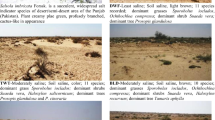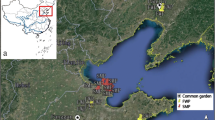Summary
Eight populations ofAgrostis stolonifera, collected from maritime and inland habitats, were grown in solution culture and in sand culture at various concentrations of sodium chloride from 0 ppm to 5,000 ppm Na.
NaCl had less effect upon the dry weight yield of populations from maritime habitats, with soils of high Na content, than upon populations from inland or maritime habitats with soils of low Na content. The correlation between per cent reduction in dry weight yield and the Na content of the native soil of each population was r=−0.73. Populations from inland or maritime habitats, with soils of low Na content, contained more Na in their shoot materials, and higher Na/K ratios, than did populations from high Na soils, at all Na concentrations.
The effect of NaCl upon the root elongation of each population was not correlated with the effect upon dry weight yield, nor with the Na content of their native soil. The effect of Na Cl upon root elongation was highly dependent upon the composition of the culture solution used. It is concluded that the effect of NaCl on root elongation is not an adequate measure of salinity tolerance in this species.
Similar content being viewed by others
References
Aston, J. L. and Bradshaw, A. D., Evolution in closely adjacent plant populations. II.Agrostis stolonifera in maritime habitats. Heredity21, 649–664 (1966).
Bernstein, L. and Hayward, H. E., Physiology of salt tolerance. Ann. Rev. Plant Physiol.9, 25–47 (1958).
Black, R. F., Effect of NaCl in water culture on the ion uptake ofAtriplex hastata. Australian J. Biol. Sci.9, 67–80 (1956).
Burström, H. G., Physiology of root growth. Ann. Rev. Plant Physiol.4, 237–316 (1953).
Burström, H. G., Calcium and plant growth. Biol. Rev.43, 287–316 (1968).
Clowes, F. A. L., Reorganisation of root apices after irradiation. Ann. Botany N.S.23, 205–210 (1964).
Clowes, F. A. L., Micronuclei and radiosensitivity in the root meristem ofVicia faba. Ann. Botany28, 345–350 (1964).
Dewey, R. D., Salt tolerance of twenty five strains ofAgropyron. Agron. J.52, 631–635 (1960).
Epstein, E., Selective ion transport in plants and its genetical control. Natl. Acad. Sci. Publ.942, 284–298 (1963).
Epstein, E. and Jefferies, R. L., The genetic basis of selective ion transport in plants. Ann. Rev. Plant Physiol.15, 169–185 (1964).
Greenway, H. and Rogers, A., Growth and ion uptake ofAgropyron elongatum on saline substrate as compared with a salt tolerant variety ofHordeum vulgare. Plant and Soil18, 21–30 (1968).
Greenway, H., Plant response to saline substrate. VII. Growth and ion uptake throughout plant development of two varieties ofHordeum vulgare. Australian J. Biol. Sci.18, 763–779 (1965).
Griffith, G. ap, Jones, D. I. H. and Walters, J. K., Specific and varietal differences in sodium and potassium in grasses. J. Sci. Food Agr.16, 94–98 (1965).
Hannon, H. and Bradshaw, A. D., Evolution of tolerance in two coexisting species of grass. Nature220, 1342–43 (1968).
Hayward, H. E. and Long, E. M., Plant growth in saline and alkali soils. Advances Agron.1, 1–38 (1949).
Hewitt, E. J., Sand and water culture methods used in the study of plant nutrition. Commonwealth Agr. Bur. Reading England (1952).
Hubbard, C. E., Grasses. 2nd Ed. Penguin books (1968).
Jowett, D., Population studies on lead tolerantAgrostis tenuis. Evolution18, 70–80 (1964).
Kessler, B., Engelberg, N., Che, D. and Greenspon, M., Studies on physiological and biochemical problems of stress in higher plants. Volcani Inst. Agr. Research Spec. Bull.64 (1964).
Kruijne, A. A. and de Vries, D. M., Gegevens betreffende belangrijke graslandplanten (Data concerning important herbage plants). Instituut voor Biologisch en Scheikundig onderzoek Van Landbouwgewassen, Wageningen Mededel225 (1963).
McMillan, C., Salt tolerance within aTypha population. Am. J. Botany46, 521–526 (1959).
Nieman, R. M. and Pulson, L. L., The light dependence of nucleic acid and protein synthesis of isolated radish cotyledonary leaves. Plant Physiol.37 (Supplement), 21–22 (1962).
Perring, F. H. and Walters, S. M., Atlas of the British Flora. Botanical Society of the British Isles (1962).
Slatyer, R. D., Plant-Water Relationships. Academic Press, N.Y. (1967).
Vose, P. B., Varietal differences in plant nutrition. Herbage Abstracts33, 1–13 (1963).
Tansley, G., The British Isles and their Vegetation. Cambridge University Press (1949).
Wilkins, D. A., A technique for the measurement of lead tolerance in plants. Nature (Lond.)180, 37–38 (1957).
Author information
Authors and Affiliations
Rights and permissions
About this article
Cite this article
Tiku, B.L., Snaydon, R.W. Salinity tolerance within the grass speciesAgrostis stolonifera L. Plant Soil 35, 421–431 (1971). https://doi.org/10.1007/BF01372673
Received:
Issue Date:
DOI: https://doi.org/10.1007/BF01372673




